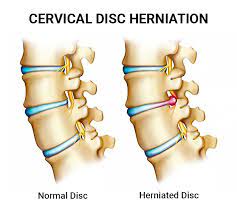
What is a Herniated Disc?
What is a herniated disk?
A herniated disk refers to a problem with one of the rubbery cushions, called disks, that sit between the bones that stack to make the spine. These bones are called vertebrae.
A spinal disk has a soft, jellylike center called a nucleus. The nucleus is encased in a tougher, rubbery exterior, known as the annulus. A herniated disk occurs when some of the nucleus pushes out through a tear in the annulus. A herniated disk is sometimes called a slipped disk or a ruptured disk.
A herniated disk, which can occur in any part of the spine, most often occurs in the lower back. Depending on where the herniated disk is, it can result in pain, numbness or weakness in an arm or a leg.
Many people have no symptoms from a herniated disk.
Symptoms
Most herniated disks occur in the lower back, but they also can occur in the neck. Symptoms depend on where the disk is sitting and whether the disk is pressing on a nerve. Herniated disks often affect one side of the body.
- Arm or leg pain. If your herniated disk is in your lower back, you’ll typically feel pain in your lower back, buttocks, thigh and calf. You might have pain in part of your foot as well.For a herniated disk in your neck, you’ll typically feel the most pain in your shoulder and arm. This pain might shoot into your arm or leg when you cough, sneeze or move into certain positions. Pain is often described as sharp or burning.
- Numbness or tingling. People who have herniated disks often have radiating numbness or tingling in the body part served by the affected nerves.
- Weakness. Muscles served by the affected nerves tend to weaken. This can cause you to stumble or affect your ability to lift or hold items.
You can have a herniated disk without symptoms. You might not know you have it unless it shows up on a spinal image.
Causes
Disk herniation is most often the result of a gradual, aging-related wear and tear called disk degeneration. As people age, the disks become less flexible and more prone to tearing or rupturing with even a minor strain or twist.
Most people can’t pinpoint the cause of their herniated disk. Sometimes, using the back muscles instead of the leg and thigh muscles to lift heavy objects can lead to a herniated disk. Twisting and turning while lifting also can cause a herniated disk. Rarely, a traumatic event such as a fall or a blow to the back is the cause.

Car Accident
A herniated disc after a car accident occurs when the force of the crash causes one of your vertebrae (bones of the spine) to push into your spinal canal where it may compress, put pressure on or otherwise irritate your spinal cord, which is the bundle of nerves that carries messages from your brain to the different parts of your body.

When to See the Doctor?
- Worsening symptoms. Pain, numbness or weakness can increase to the point that they hamper your daily activities.
- Bladder or bowel dysfunction. Cauda equina syndrome can cause incontinence or trouble urinating even with a full bladder.
- Saddle anesthesia. This progressive loss of sensation affects the areas


